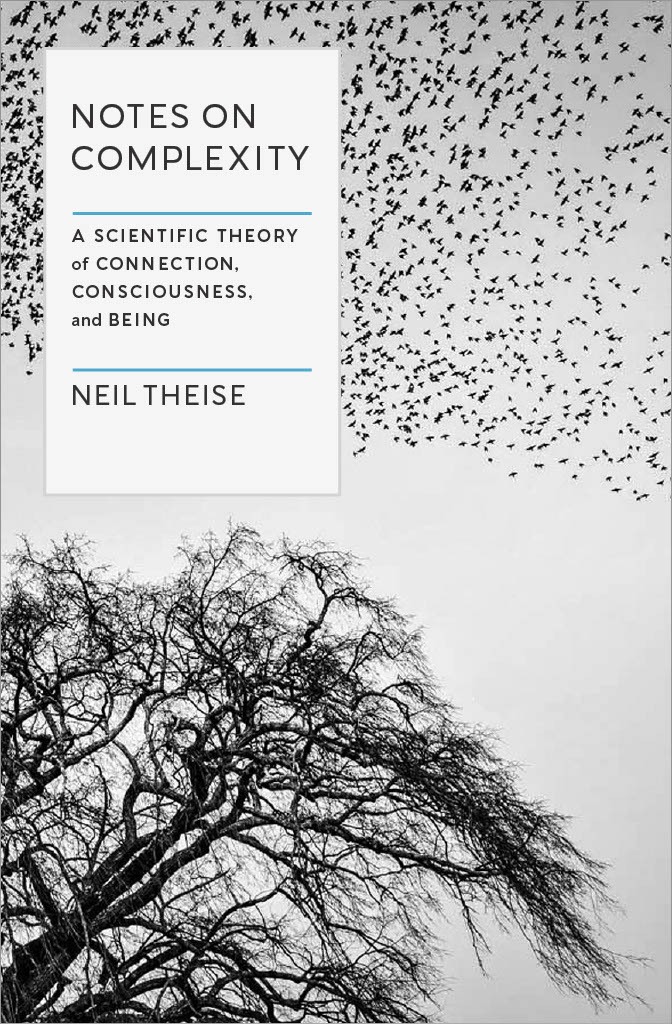The following is an excerpt from the book Notes on Complexity: A Scientific Theory of Connection, Consciousness, and Being by Neil Theise.
One
A Science of Being
Nothing in the universe is more complex than life. Microscopic life abounds both in the scalding, pressurized, sunless depths of ocean trenches and upon the highest, frozen Himalayan peaks. In between, throughout skies, in oceans, and across lands, life is endlessly on the move. And, surely, in the billions of years in which organisms will continue to thrive on the planet, there will be vastly more life forms, with variety beyond anything we might imagine.
The complexity of all this rich abundance has long resisted explanation. The origins of life remain deeply mysterious. What biological wonders might emerge next are beyond our knowing. If we were even to begin to fathom it all, a theory of complexity was necessary.
Complexity theory is the study of how complex systems manifest in the world. The use of the word complexity here does not mean “complicated,” however. Complexity in this context refers to a class of patterns of interactions: open-ended, evolving, unpredictable, yet adaptive and self-sustaining. It is this complexity that we will explore—how life self-organizes from the substance of our universe, from interactions within the quantum foam to the formation of atoms and molecules, cells, human beings, social structures, ecosystems, and beyond.
A distinguishing feature of life’s complexity is that, in every single instance, the whole is greater than the sum of its parts. Even if one knows the characteristics and behaviors of all the individual elements of a living system (a cell, a body, an ecosystem), one cannot predict the extraordinary properties that emerge from their interactions. In complexity theory, these surprising outcomes are called emergent properties or just plain emergence.
This unpredictability is both a core subject of complexity theory and a key feature of what it has to offer our understanding of the world. Neither we nor our universe is machinelike. A machine doesn’t have the option to change its behavior if its environment changes or becomes overwhelming. Complex systems, including human bodies and human societies, can change their behaviors in the face of the unpredictable. That creativity is the essence of complexity.
The whole is greater than the sum of its parts. So much is packed into that simple expression. Colloquially, the phrase evokes community, teamwork, elevated purpose—the ways in which people, with their own differing talents and abilities, when working together, can create synergies beyond the scope of what any of the individuals alone might have been capable of producing on their own. A winning team. A social movement. A perfect dinner party.
But complexity extends far beyond human beings and their social behavior. Examples of complex systems are found not only in sociology and biology but also in chemistry and physics. The universe is a shimmering web of complexity that continually births and nurtures life, tempting us to believe that life might even be its central purpose and most fundamental expression.
Complexity bridges the seemingly unbridgeable gap between the universe at its most infinitesimal, described by quantum mechanics, and at its most vast, described by the theory of relativity. As successful as these two most successful of all scientific theories have been, they are unable, on their own, to illuminate how we go from the most basic elements of existence (space, time, matter, energy) to the complex behaviors of living organ- isms and their social structures: ecosystems, cultures, and civilizations. It is complexity theory that shows how the entities arising from fundamental physics actively weave themselves into ever larger structures, step by step, until they become the fabric of our everyday lives and of the dynamic, natural, living systems that surround us.
While the aims of complexity science are grandly ambitious, when studied with careful intention, its lessons can also be deeply personal. It can solve some of the most crucial riddles of our sense of being.
In the womb and for a relatively short time afterward, we are in a seamless world in which we experience no divisions: there is no self and no other, no baby and no mother. Gradually, inevitably, in early infancy, we move from this state of intimate wholeness into another state, one of separation. We become bounded by our skin: everything inside it an “I,” everything outside it “the world.” Parts, not wholes.
Occasionally, if we are fortunate, we find ourselves in a situation with other people in which we achieve that feeling of complete unity, of something bigger than ourselves. In the absence of that experience, many of us will spend our days struggling to understand how “I” and “the world” relate. If we’re at all able to recall that sense of seamless unity, we may look over our shoulder and wonder, “How can I get back to that?” And if we’re not able to recall it, we may instead just be left with the uneasy sense that something is missing, even though we’re unsure what that something is.
Complexity theory not only provides us with scientific under- standing, but as we travel down its paths, the implications of the theory can also enlighten us, providing insight into everything from the permeable boundaries of our bodies to the nature of consciousness. Complexity theory can foster an invaluable flexibility of perspectives and awaken us to our true, deep intimacy with the larger whole, so that we might return to what we once had: our birthright of being one with all.
